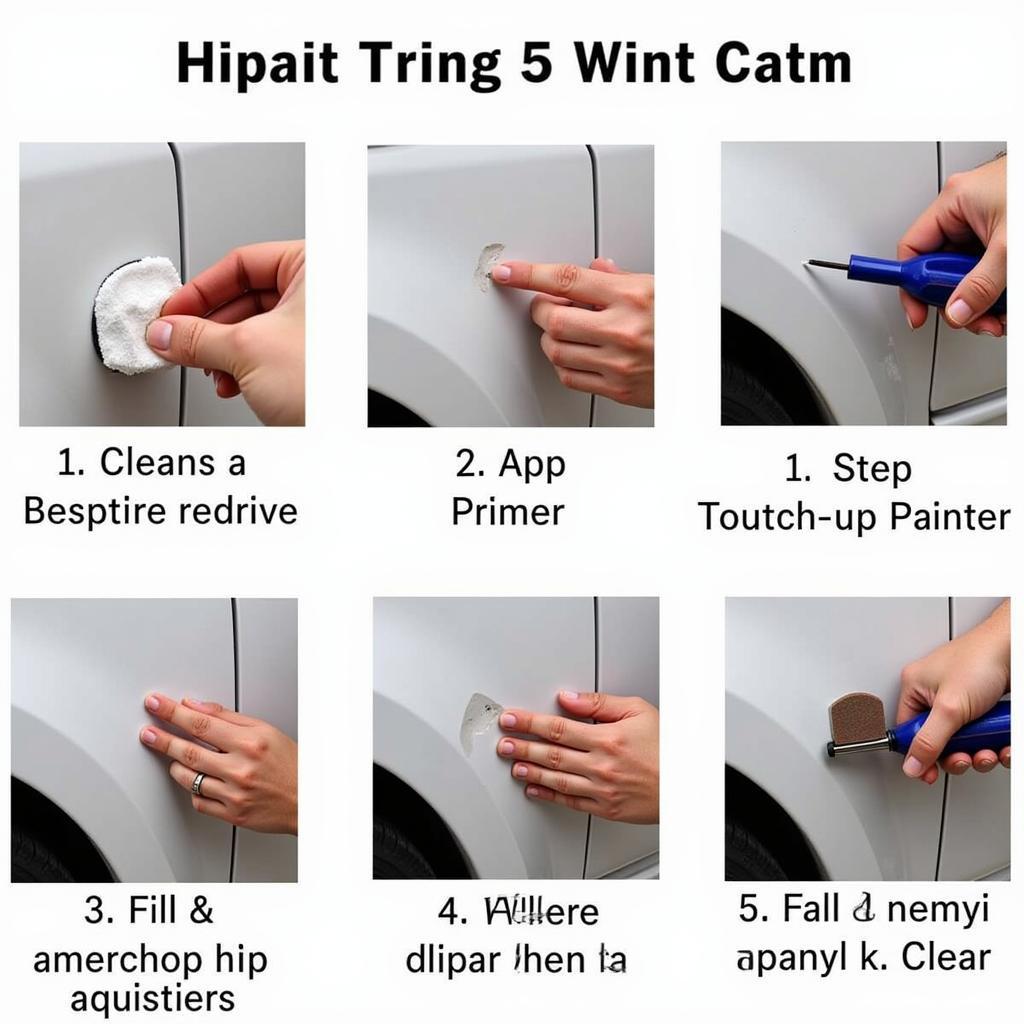Chip repair car paint is a cost-effective solution to address minor paint damage on your vehicle, restoring its appearance and protecting it from further deterioration. From understanding the process to choosing the right repair kit, this guide provides everything you need to know about fixing those annoying paint chips.
Understanding the Importance of Chip Repair
Paint chips, though seemingly minor, can expose the underlying metal to the elements, leading to rust and corrosion. Addressing these chips promptly prevents further damage and maintains your car’s value. Repairing paint chips is often a simple DIY project, saving you the expense of a professional repair. Don’t let small chips turn into big problems.
repair minor paint damage for a car
How to Repair Paint Chips on Your Car
Repairing a paint chip is a straightforward process that involves cleaning, priming, filling, sanding, and painting the affected area. First, clean the chipped area with soap and water, removing any loose paint or debris. Next, apply primer to the bare metal to ensure proper paint adhesion. Then, carefully fill the chip with touch-up paint, using a fine-tipped brush or a paint pen. Allow the paint to dry completely before lightly sanding the area to blend it seamlessly with the surrounding paint. Finally, apply a clear coat to protect the repair and restore the shine.
Choosing the Right Chip Repair Car Paint Kit
Selecting the correct paint for your car’s chip repair is crucial for a seamless and professional-looking finish. Your car’s paint code can usually be found on a sticker inside the driver’s side doorjamb or in the owner’s manual. When choosing a chip repair kit, consider the type of paint, the application method, and the included tools. Some kits come with a brush, while others use a pen applicator.
DIY vs. Professional Chip Repair: Which is Right for You?
While many chip repairs can be handled with a DIY approach, larger or more complex chips may require professional attention. Factors to consider include the size and depth of the chip, the location of the damage, and your level of comfort with DIY projects.
Preventing Future Paint Chips
Protecting your car’s paint from future chips involves preventative measures like regular washing and waxing, parking strategically, and using paint protection film. Regularly washing your car removes dirt and grime that can scratch the paint. Waxing provides an additional layer of protection. Parking away from other cars and avoiding driving on gravel roads can also minimize the risk of chips.
Why is Chip Repair Important for Car Resale Value?
Maintaining your car’s paint in good condition, including repairing chips, significantly impacts its resale value. A well-maintained exterior gives potential buyers the impression that the car has been cared for, making them more willing to pay a higher price. Small chips can detract from the overall appearance and suggest neglect, potentially lowering the resale value.
“Addressing paint chips promptly not only preserves your car’s appearance but also protects its value in the long run,” says renowned automotive expert, David Miller, founder of Miller’s Auto Detailing. “It’s a small investment that can yield significant returns.”
Conclusion
Chip repair car paint is an essential aspect of car maintenance. By addressing these minor imperfections promptly and effectively, you can protect your car from further damage, maintain its aesthetic appeal, and preserve its resale value. From understanding the process to selecting the right repair kit, this guide equips you with the knowledge to tackle those pesky paint chips with confidence.
FAQ
-
How long does chip repair take? The drying time for touch-up paint varies depending on the product and environmental conditions, but it typically takes a few hours to dry completely.
-
Can I repair any size chip? While DIY chip repair kits are effective for small to medium-sized chips, larger or more complex damage might require professional repair.
-
What if the chip has reached the metal? If the chip has exposed the metal, it’s crucial to apply primer before filling it with touch-up paint to prevent rust.
-
How can I find my car’s paint code? The paint code is usually located on a sticker inside the driver’s side doorjamb or in the owner’s manual.
-
Where can I buy a chip repair kit? Chip repair kits are readily available at most auto parts stores and online retailers.
-
What is the average cost of professional chip repair? Professional chip repair costs can vary but typically range from $50 to $200 per chip, depending on the size, location, and complexity of the damage.
-
Can I wash my car after chip repair? It’s best to wait at least 24 hours after the repair before washing your car to allow the paint to fully cure.
Common Chip Repair Scenarios
- Scenario 1: Small, shallow chip on the hood: A DIY repair kit is usually sufficient.
- Scenario 2: Deep chip exposing metal on the door: Primer application is crucial before filling.
- Scenario 3: Multiple chips clustered together: Professional repair might be more cost-effective.
Further Reading
For more information on related topics, explore these articles on our website: How to Repair Minor Scratches, Choosing the Right Car Wax, and Protecting Your Car’s Paint.
“Regular maintenance, including addressing paint chips, demonstrates a commitment to preserving your vehicle’s condition,” adds Sarah Johnson, a leading auto appraiser. “This attention to detail can significantly influence a buyer’s perception and ultimately, the resale value.”
For any assistance or inquiries, please don’t hesitate to contact us via WhatsApp: +1(641)206-8880, Email: [email protected]. Our customer service team is available 24/7 to help you.


